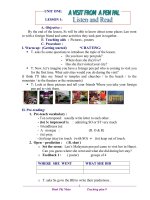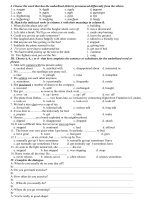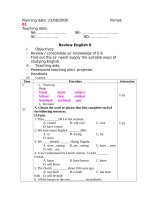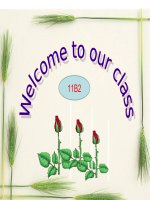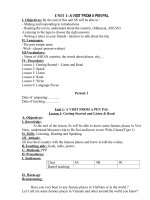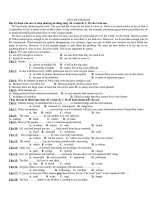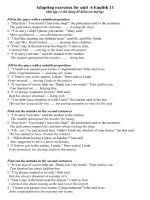unit 1 English 11
Bạn đang xem bản rút gọn của tài liệu. Xem và tải ngay bản đầy đủ của tài liệu tại đây (99.97 KB, 10 trang )
<span class='text_page_counter'>(1)</span><div class='page_container' data-page=1>
Unit 1
<b>FRIENDSHIP</b>
<b>Period 1</b>
<b>(Reading)</b>
<b> I. Objectives:</b>
By the end of the lesson, the Ss will be able to know the value of the true friend .
Read and guess meaning in context.
Passage comprehension
<b>II. Teaching method: communicative approach</b>
<b>II. Teaching aids: textbooks, pictures, handouts, reference books, cassette ..</b>
<b>IV. Procedures:</b>
<b>Teacher’s activities</b> <b>Students’ activities</b>
<b>1.Warm - up (5ms)</b>
Stick the picture in the textbook on the Bb
Ask some questions:
- What are the people in the picture doing?
- What is the boy doing?
- Are they happy?
- In your opinion, what relationship are they?
Ask Ss to open the book and read the poem about a friend .
- What do you think about friendship?
- Do you have friends? What is a good friend like, according
to you?
- What quality should we have to have true friendship?
Transition: - In today’s reading, we’ll get to know more about
friend and friendship.
<b>2. Before you read (10ms)</b>
<b>a. Pre- teach vocabulary:</b>
- Unselfish (a) : (example)
- Constancy (n) ( translation)
- Loyalty (n) ( situation)
- Trust (v) ( synonym)
- Suspicion (n) ( antonym)
- Sympathy (n) ( translation)
<b>3. While you read (18ms)</b>
<b>b. Task 1: Give Ss the hand-outs</b>
Look at the picture
Answer the questions
Read the poem and tell the
meaning.
Ask the questions.
Take part in the teacher’s work.
Copy and say the words after the
teacher.
</div>
<span class='text_page_counter'>(2)</span><div class='page_container' data-page=2>
( sentences in task 1)
Feedback
Ask Ss to open their book and read the passage and do task
two in pairs
<b>c. Task 2 : ( pairwork)</b>
Key: B ( Conditions of true friendship)
<b>d. Task 3: </b>
- Run through all the questions before asking Ss to
work in pairs.
- Monitoring
- Give help if necessary
- Give feedback
4. After you read ( 10ms)
Ask Ss to work in groups to discuss the question : “ Why do
we need to have friends?”
Remarks
<b> 5.Homework (2ms )</b>
- Learn the new words.
- Do the task three again in their notebooks.
- Prepare for the speaking.
Read out their sentences, others
give remarks
Pair-work
Translate all the questions
Work in pairs.
Practice asking and answering
+ Close pairs
+ Open pairs
Work in groups of four
Present their discussion
Unit 1
<b>FRIENDSHIP</b>
<b>Period 2</b>
<b>(Speaking)</b>
<b>I. Objectives:</b>
By the end of the lesson, the Ss will be able to know how to describe their
friends.
Describing physical characteristics.
Discussing personalities.
Role playing: talking about a famous friend.
<b>II. Teaching method: communicative approach</b>
<b>II. Teaching aids: textbooks, pictures, handouts.</b>
<b>IV. Procedures:</b>
</div>
<span class='text_page_counter'>(3)</span><div class='page_container' data-page=3>
<b>1.Warm - up (5ms)</b>
Give the handouts.
Match the adjective from the box with the parts of the body:
Short – broad – straight – tallish – crooked – pointed
– oval – turn-up square – flat – large – wide –
wrinkled – dyed – long - curly
Parts of the body Adjectives
Face
Nose
Hair
Forehead
Height
Ask some pairs go to the Bb
Give feed back
<b> 2. Pre- speaking (10ms)</b>
Help Ss to read those words
Help them use those words in their own sentences to describe
one of their friends in their class.
Elicit them by asking:
+ What does he / she look like?
+ What is / she like?
+ Is he / she tall?
<b> 3. While- speaking (18ms)</b>
<b> a. Task 1:</b>
Ask Ss to open their books and describe the four persons in
the textbook.
Give them some useful expressions:
- He is of medium height.
- He has got a square face with blue eyes..
- She wears her hair in a pony tail.( đuôi ngựa)
- Her long hair hangs down to her shoulder..
Model dialogue:
T: Could you tell me something about your friend? What’s
he like?
S: Oh, he is friendly.
T: What does he look like?
S: Tall and good-looking.
<b>e. Task 2 : ( group work)</b>
Ask Ss to rearrange the adjectives in order of
importance of friendship and tell the reasons of their choice.
<b>f. Task 3: </b>
- Set the scene and ask Ss to work in groups to make
Get the handouts and
work in pairs.
Fill in the gaps
Correct their papers
Read the words
Describe one of their
friends.
Take part in the teacher’s
work.
Open their books and
describe
Copy and say the
expressions after the
teacher.
Work in pairs to practice
the dialogue.
Group work
Explain their choice
</div>
<span class='text_page_counter'>(4)</span><div class='page_container' data-page=4>
questions or facts about a famous friend based on the
suggestions in the textbook before doing the task
- Monitoring
- Give help if necessary
T: Hello, I’m ……… I’m a journalist for …..
T: I know you are ……..….friend. Could you give me some
information about ……..?
- When was he born? / What’s he like?
- What’s his hobby? / What does he do in his free
time? / Why is he interested in math? / how much time
does he spend on math?/ What made him so
successful?, etc …..
T: Thanks for giving me time. Bye.
<b>4. Post speaking ( 10ms)</b>
- Give feedback and remark
<b>5. Homework (2ms)</b>
- Learn the new words.
- Write a short paragraph about their friend.
- Prepare for the listening.
task
Practice asking and
answering
+ Close pairs
+ Open pairs
Unit 1
<b>FRIENDSHIP</b>
<b>Period 3</b>
<b>(Listening)</b>
<b> </b>
<b> I. Objectives:</b>
By the end of the lesson, the Ss will be able to understand the daily activities of a
laborer.
Deciding on True or false statements..
Listening and taking notes.
<b>II. Teaching method: communicative approach</b>
<b>II. Teaching aids: textbooks, pictures, handouts, cassette player.</b>
<b>IV. Procedures:</b>
<b>Teacher’s activities</b> <b>Students’ activities</b>
<b>1.Warm up (5ms) Checking the previous lesson</b>
- Talk about his /her famous friends
- Feedback
</div>
<span class='text_page_counter'>(5)</span><div class='page_container' data-page=5>
<b>2.Pre – listening (10 ms)</b>
1. Matching
1. apartment building picture 4
2. sense of humour picture 1
3. guitarist picture 5
4. motorbike picture 2
5. around picture 3
- Call Ss to do matching on BB
- Correct
- Read the word as model
- Model the dialogue:
T: Who is your best friend?
T: How did you meet him / her?
T: How long have you known each other?
T: What qualities do you admire in your best friend?
Set the scene to teach the new words:
Apartment building ( translation)
Guitarist ( picture)
Motorbike ( picture)
Sense of humour ( translation)
Favourite (example )
To share (situation)
To introduce ( situation)
Help Ss to read those words
Help them use those words in their own sentences to
describe one of their friends in their class.
3. While- listening (18ms)
Ask Ss to open their books
<b> a. Task 1:</b>
Ask the students to go through the statements
Elicit the key words so that they focus on listening.
Have them listen to the tape twice
Ask Sts to write the answers on the Bb.
Ask other students to remark and correct .
Let Ss to listen the tape again.
Give feedback.
Suggested keys:
- Talk A:
1 2 3 4 5 6
F F T F T F
Ask Ss to correct the statements if possible
<b>b. Task 2: </b>
- Set the scene and explain
- Tell Ss the way of doing this exercise.
- Work in pairs
- Matching on BB
- Take notes
- Listen and repeat
Listen and take part in the
dialogue.
T S , S S
Copy down and read the words
after the teacher.
Give the meaning
Make examples
Open their books
Read the statements and
understand them before listening
Listen and do the task
Do as directed
Listen and compare their
answers.
- Talk B:
1 2 3 4 5 6
F F T T T F
Listen and do the task in pairs
</div>
<span class='text_page_counter'>(6)</span><div class='page_container' data-page=6>
- Have them listen twice.
- Let Ss listen to the tape one more and ask them
to give the answers
<b>4. Post - speaking ( 10ms)</b>
How / where they
met
What do they like....
Lan - used to live in the
same residential
area in Hanoi.
- Lan in Doson, Ha
went to help
- friendly and helpful.
- Ha knew many people
and introduced Lan
around.
Long - met in college.
- Minh played the
guitar
- Long sang.
- a great sense of
humour.
- good listener.
- friendly and helpful.
- Give feedback and remark
* Ask Ss to retell the relationship between Lan and Ha,
Long and Minh.
* Give the handouts of some proverbs about friendship
and ask them to give their opinions.
1. With a friend at your side, no road seems too long
( Japanese proverb)
2. Hold a true friend with both your hands. ( Nigerian
proverb)
3. One can do without people, but one has need of a
friend. ( Chinese proverb)
Ask some students to tell about their discussions.
<b>5.Homework (2ms)</b>
- Learn the new words.
- Write about you and your friend has become best
friends - Prepare for the writing.
Listen again and give the answers
Go to the Bb to write down their
answers.
Practice asking and answering
based on the chart.
+ Close pairs
+ Open pairs
Work in groups.
</div>
<span class='text_page_counter'>(7)</span><div class='page_container' data-page=7>
Unit 1
<b>FRIENDSHIP</b>
<b>Period 4</b>
<b>(Writing)</b>
<b>I. Objectives:</b>
By the end of the lesson, the Ss will be able to write a short paragraph to
describe their friends.
<b>II. Teaching method: communicative approach</b>
<b>II. Teaching aids: textbooks, handouts.</b>
<b>IV. Procedures:</b>
<b>Teacher’s activities</b> <b>Students’ activities</b>
<b>1. Warm up (5ms)</b>
Expanding sentence:
- Write the word “Friend” on the Bb
- Ask Ss to expand it by adding the beginning or the end to
make a meaningful sentence.
Introduce the new lesson.
2. Pre- writing (10ms)
Review some useful words that helps them to describe
someone ( speaking lesson)
Short - broad - straight - tallish - crooked - pointed -
oval - turn-up square - flat - large - wide - wrinkled -
dyed - long - curly
Parts of the
body
Adjectives
Face
Nose
Hair
Forehead
Height
<b> 3. While- writing (20ms)</b>
Ask Ss to open their books
Go through all the guidelines
Elicit some structures:
a). S + VL + Adjectives
b). S + To have + Noun ....
Look and do as directed
Give the meaning
Make examples
</div>
<span class='text_page_counter'>(8)</span><div class='page_container' data-page=8>
+ What I like most about him / her is...
+ We have the same interest in ..
+ It is her / him who I can share..
+ I first met him / her in ( when ...
Help Ss to make the outline
Limit Ss time to finish writing
Monitoring
Share their ideas and writing with his friend
Ask two students write their writing on the Bb.
<b>4. Post- writing ( 8ms)</b>
Let Ss to remark before giving feedback.
Correct the mistakes and give marks.
<b>5. Homework (2ms)</b>
- Learn the new words.
- Write the passage again in their textbooks.
- Prepare for the language focus.
Make the outline before
writing
Check his friend’s writing .
Come to the Bb
Others give their opinions
Correct their mistakes
Unit 1
<b>FRIENDSHIP</b>
<b>Period 5</b>
<b>(Language Focus)</b>
<b>I. Objectives:</b>
By the end of the lesson, the Ss will be able to pronounce and know the
differences between the two sounds /ʧ/ & /ʤ/
Know and use the bare infinitive and full infinitive.
<b>II. Teaching method</b>: communicative approach
<b>II. Teaching aids</b>: textbooks, handouts.
<b>IV. Procedures:</b>
<b>Teacher’s activities</b> <b>Students’ activities</b>
<i><b>1). Pronunciation:</b></i>
a). Show pictures of “Chair” & “Bridge”
- Ask Ss to read those word and tell the differences
- Ask Ss to give other words containing those sounds.
- Introduce the new lesson
- Ask Ss to open their books
b). Read those sounds and ask Ss to repeat
Look and do as directed
</div>
<span class='text_page_counter'>(9)</span><div class='page_container' data-page=9>
- Read words and sentences on page 19
- Ask Ss to tell the letters containing those sounds.
The letters such as “Ch, Tu, Tch” contain the
sound /ʧ/ ( question, righteous)
The letters such as “J, G, Dg” contain the sound /ʤ/
( soldier, educate)
c). Listen and decide if the word belonging to group
1 /ʤ / or group 2 / ʧ /
Age, each, badge, coach , college, chew,
junk, jeans, joke, purchase, magic, match, tragic
<i><b>2). Grammar:</b></i>
Stick a sentence on the Bb
- Ex: They arrived late last night.
I saw ...
Expected answer : “I saw them arrive late....”
Ask Ss to give more verbs following the bare infinitive if
possible.
Introduce the new lesson
Write the structure on the Bb
<b>S+ Perceptive verbs + Object + Bare inf</b>
- see - hear - listen to
<i> - watch - feel - smell - taste</i>
<i> - observe , notice</i>
<i> * Other verbs : let make , help</i>
<b> a). Task 2</b>
Have Ss practice the exercises given in the textbook
Ask Ss to read out the answers
Give them a chance to practice the structures by using model
dialogue:
A: Where is Nam?
B: I saw him go out a minute ago.
A: What wrong with him?
B: I heard him say that he is not well.
<b> b). Task 1</b>
Set the scene to teach the “To-inf”
Read those sounds
Do as directed
Give the meaning
Make examples
Listen and give the answers
( class work)
Look at the Bb and do as
directed
Discuss and give the answer
Listen and take part in their
teacher’s work
Tell the meaning
Make examples
Copy down
Do the exercise and compare
with the partner
Practice the dialogue and
replace situation if possible.
Answer the teacher’s
questions
</div>
<span class='text_page_counter'>(10)</span><div class='page_container' data-page=10>
What do we go to school for?
What do you learn English for?
* We go to school to enrich our mind with
knowledge.
* I study English to go abroad / to speak to the
foreigner / to find a good job.
“To infinitive” is used in these sentences to express a
purpose.
Ask Ss to do the given exercises in textbook.
Give feedback
<b> Homework:</b>
* Make questions for the responses:
1). I saw him sit in the park alone.
2). Nothing. I think we have to eat out today.
3). Too tired to go now.
4). Why not? Let’s join them.
5). Oh, he‘s old enough.
- Learn the new words.
- Do the exercises again in their notebooks
- Prepare for the unit 2
Open their books and do the
exercises.
Come to the Bb ad write down
their answer.
</div>
<!--links-->



